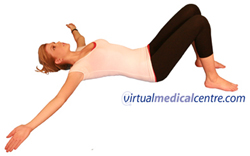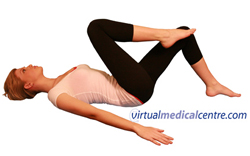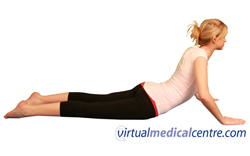- What is Pilates?
- Back pain
- How does core stability relate to back pain?
- Is Pilates useful for people with back pain?
- Is Pilates safe for people with back pain?
- What are the risks of Pilates for people with back pain?
- How do I modify Pilates if I have back pain?
- Some examples of Pilates exercises that are useful for back pain
- Where should I do Pilates if I have back pain?
- Top tips for people with back pain who do Pilates
What is Pilates?

Throughout Pilates exercises, the lower abdominal and pelvic floor muscles remain contracted, increasing their strength, and helping support the back.
Back pain
Back pain is extremely common. In Australia, 15–20% of the population report having back pain or disc problems, roughly equal to four million Australians. It is estimated that 85% of the population will experience back pain at some point in their lives. Those most at risk of developing back pain are people who are overweight or inactive; who spend a lot of time sitting at work; or whose jobs require them to lift, twist and bend. Stress and smoking also place people at risk of developing back pain. People with conditions such as arthritis, scoliosis, and cancer are more likely to experience back pain. Back pain becomes more common as people get older, with the first episode occurring most commonly around 30 to 40 years of age.
Back pain can drastically reduce quality of life. Many people who experience back pain become less involved in work, exercise and social activities. Back pain, especially when it is chronic, often has a large impact on an individual’s relationships, endocrine system, and role in the family and the community. A combination of these effects, and the back pain itself, can have an enormous impact on psychological health. Many studies have shown that for the vast majority of people with back pain, it is essential that they ‘keep moving’ in order to effectively manage their condition. Carefully monitored exercise programs that are designed to allow improvements in mobility, strength and flexibility without worsening back pain are an integral component of the effective treatment of back pain.
How does core stability relate to back pain?
People with back pain tend to have weaker abdominal muscles than people without back pain. The deep abdominal muscles (transversus abdominis) are responsible for helping to provide support to the back (they work like a corset). Strength in the deep abdominal, pelvic floor and back muscles, providing support to the spine and a strong base for movement, is known as core stability. If the deep abdominal muscles are weak, the back is vulnerable to injury.
Is Pilates useful for people with back pain?
Pilates is a particularly good exercise for many people with back pain as it is designed to strengthen the deep abdominal and pelvic floor muscles, which provide support to the back. Pilates has been found to reduce chronic back pain and the disability associated with back pain. These improvements are maintained over a long period of time.
Exercising in certain positions can make back pain worse. Pilates exercises can be modified so that aggravating positions are avoided and relieving positions are emphasised. The level of difficulty of the exercises can be modified according to the irritability and severity of pain. Physiotherapists who have specialised in clinical Pilates may use Pilates equipment and exercises specifically to help treat back pain.
Before starting a clinical Pilates program, most physiotherapists will take photos of your posture to identify problems, and will use ultrasound to see how well the lower abdominal muscles and pelvic floor are working. This is useful for identifying areas that need improvement, and for deciding on the exercises that will focus on these areas.
Posture and muscle strength can be reassessed following a period of Pilates to see how much progress has been made.
Is Pilates safe for people with back pain?
Check with your doctor or specialist before starting any new exercise program, particularly if you have any back problems. Any exercise performed incorrectly may make your back pain worse, so it is essential that you receive individual attention from a physiotherapist or qualified Pilates instructor. Don’t try exercises on your own until a professional has assessed your performance and understanding of the basics.
In order to effectively improve support for your back, and to prevent injury, you must be able to perform an effective pelvic floor and deep abdominal contraction. The basic Pilates exercises are designed to achieve this contraction. If you cannot contract your pelvic floor or deep abdominals muscles effectively, more advanced exercises may place too much strain on your back and other joints. This is why it is important to be assessed by a Pilates instructor or physiotherapist before continuing with exercises to make sure your technique is correct.
Certain exercises will not be appropriate for people with back pain. Depending on the cause of the pain, and other factors, each person with back pain has individual ‘aggravating’ and ‘relieving’ positions. Exercises can be modified to avoid any positions that will make pain worse, and focus on exercises that will improve the pain. For example, back pain due to a bulging disc may be made worse by sitting and bending positions, while extension exercises may be helpful. In other individuals, the opposite will apply. This is why it is essential that people with back pain are thoroughly and carefully assessed by a physiotherapist or health professional before starting Pilates.
General Pilates classes tend not be suitable for people with back pain. They may involve positions that are not appropriate, and may progress too quickly. Clinical Pilates (in small groups of around 4, with a physiotherapist) or studio Pilates (in small groups of around 4) are more appropriate. These classes tend to be based on equipment, which will provide a greater variety of exercises.
What are the risks of Pilates for people with back pain?
- Any exercise performed incorrectly may exacerbate back pain.
- Certain positions may make back pain worse. These vary according to the individual. Although good assessment from a health professional before starting Pilates aims to identify the positions that make pain worse, some aggravating positions may not be discovered until they occur during Pilates exercises.
- It is possible to ‘over-do it’ during any exercise, particularly as pain settles down and confidence improves. It is important to keep your progress gradual, and to be constantly reassessed by your instructor.
- Certain conditions that cause back pain may be worsened by exercise. This is why it is essential to be assessed by your doctor before starting Pilates.
- It is possible to lose your balance, fall, or jar your back during Pilates exercises, which could make back pain worse.
How do I modify Pilates if I have back pain?
- Modification of Pilates exercises will vary according to the cause of your back pain and the positions that make it worse. Your Pilates instructor will guide you to exercises that are appropriate and those that are not.
- Any exercises that cause a ‘niggling’ back pain should not be continued. This pain indicates that the abdominal muscles are not yet strong enough to support the back during that exercise.
- As with all exercise, let your instructor know if you do not feel comfortable or confident. You know your back best, and you need to listen to your body.
- Time any medication you take for your back pain around your Pilates classes according to your health professional’s advice.
- Make sure you provide your Pilates instructor with detailed feedback about how your back responded to previous sessions. This will help them to modify and progress your program appropriately.
- Apply the principles of core stability and good posture that you learn during your Pilates sessions to your everyday life. This will maximise the benefit you obtain from Pilates, particularly if you have back pain.
Some examples of Pilates exercises that are useful for back pain
These exercises can cause harm if performed incorrectly. You should be supervised by a clinical Pilates instructor to make sure you are doing them properly before carrying them out on your own. This is particularly important for people with back pain.
If back pain occurs during any of these exercises, stop the exercise and talk to your instructor.
These exercises can be performed in any position. To start, perform these exercises in a sitting position, or on hands and knees.
The pelvic floor muscles are those around the vagina and back passage. To contract them, draw the muscles ‘up and in’. Imagine the muscles you would tighten to prevent passing wind from your back passage, or to stop the flow of urine. Practice tightening these muscles around the back passage, then try the same contracting movement further forward. You should not be tightening your buttock or leg muscles. Do not practice these exercises by stopping urine flow when you are on the toilet. The most serious mistake people make when carrying out these exercises is to ‘bear down’ or push down rather than ‘lifting up’. This straining actually stretches the pelvic floor and makes it weaker.
Some programs suggest a series of ‘quick flicks’ of 2 second pelvic floor contractions, followed by sustained 5 second contractions, aiming to build up to 10 second contractions.
Relax your pelvic floor completely for 10 seconds between each contraction. Do not hold your breath during contractions. It is important to concentrate and focus on each separate contraction.
Basic deep abdominal contraction
Lie on your back with your knees bent (crook lying), or kneel on your hands and knees (four point kneeling). Check that your back is almost flat (don’t tilt your pelvis too far forward or ‘arch’ your back).
Breathe in. On the breath out, contract your pelvic floor, and gently draw your belly button down towards your spine (crook lying), or lift your belly button up towards your spine (4 point kneeling). Do not ‘suck in your stomach’. The contraction should be gentle (about 30% of maximum effort).
Try to maintain this pelvic floor and abdominal contraction for 10 seconds. Do not hold your breath or move your back during this time. Gently relax after 10 seconds. Repeat this exercise 10 times.
Maintain a deep abdominal muscle and pelvic floor contraction while sitting on the ball and alternately lifting your legs off the ground. Maintain good posture, and keep the rest of the body stable and still throughout.
Lie on your back with your knees bent. Maintain a deep abdominal muscle and pelvic floor contraction while raising and lowering your arms above your head. Keep your shoulders low and your ribcage down.
Lie on your back with your knees bent. Maintain a deep abdominal muscle and pelvic floor contraction while lifting a bent leg off the ground and placing it back down. Repeat with the other leg. Do not allow the pelvis to move while you carry out this exercise. Do not arch your back.
Kneel on your hands and knees with your back and pelvis in a neutral position. While maintaining a deep abdominal and pelvic floor contraction:
- Raise one arm out in front and put back down
- Raise one leg up and put back down
- Raise one arm and the opposite leg up and put back down
- Raise one arm and the leg on the same side up and put back down
Maintain the position of your lower back and pelvis throughout.
Lie on the mat face down. Place your hands under your shoulders, keeping your elbows in at your side. Contract your lower abdominal and pelvic floor muscles, and gently press up with your arms to arch your back. Keep your head in line with your spine. Keep your hips on the floor.
Pelvic circles leaning on ball
Using the ball for support, move your hips in progressively larger circles while maintaining a lower abdominal and pelvic floor contraction.
Where should I do Pilates if I have back pain?
All people with back pain are advised to check with their doctor before commencing Pilates.
Pilates for people with back pain should ideally be carried out by a physiotherapist or other health professional who specialises in Pilates. This is known as clinical Pilates. These specialists are not only trained in the Pilates technique, but also have a good understanding of back pain and spinal pathology. Many private physiotherapy practices offer this service. A private health fund rebate is often available for clinical Pilates classes.
Once you become familiar with Pilates exercises, it may be safe to practice some basic exercises at home (if your instructor feels you are ready for this). Indeed, incorporating abdominal contraction and good posture into your daily activities will result in maximum benefit from the program. However, as back pain tends to fluctuate, ongoing instruction is ideal. Your exercises can then be safely progressed or modified according to your back pain and improvement.
It is not recommended that people with back pain start Pilates on their own (with DVDs, books, etc) or in large classes without receiving assessment and feedback from a clinical Pilates instructor to ensure that they are performing the basics correctly.
Top tips for people with back pain who do Pilates
- Before starting Pilates classes, consult your doctor.
- Have an assessment of your posture by a physiotherapist/qualified instructorbefore starting Pilates to make sure the appropriate program is chosen.
- Have an assessment of your pelvic floor and abdominal strength by a qualified instructor to ensure you are carrying out the exercises correctly.
- Provide good feedback to your Pilates instructor so they know how your back is responding to the exercises.
- Wear comfortable nonrestrictive clothing.
- Continue classes with a clinical Pilates instructor so the program can be modified appropriately according to your back pain.
- Take care with your balance. Do not get up from the floor too quickly.
- Be guided by a health professional in regards to timing of any medication you take for your back pain around your Pilates classes.
- Do not carry out any exercises you do not feel comfortable with, particularly those that cause niggling pain.
- Apply the principles of core stability and good posture that you learn during your Pilates sessions to your everyday life. This will maximise the benefit you achieve from Pilates.
References
- Lee CY, Kratter R, Duvoisin N, Taskin A, Schilling J. Cross-sectional view of factors associated with back pain. International Archives of Occupational & Environmental Health. 2005; 78(4): 319-24.
- Plowman SA. Physical activity, physical fitness, and low back pain. Exercise & Sport Sciences Reviews. 1992; 20: 221-42.
- Nouwen A, van Akkerveeken PF, Versloot JM. Patterns of muscular activity during movement in patients with chronic low-back pain. Spine. 1987; 12(8): 777-82.
- Smidt G, Herring T, Amundsen L, Rogers M, Russell A, Lehmann T. Assessment of abdominal and back extensor function. A quantitative approach and results for chronic low-back patients. Spine. 1983; 8(2): 211-9.
- Rydeard R, Leger A, Smith D. Pilates-based therapeutic exercise: Effect on subjects with nonspecific chronic low back pain and functional disability: A randomized controlled trial. Journal of Orthopaedic & Sports Physical Therapy. 2006; 36(7): 472-84.
- Bo K, Talseth T. Long-term effect of pelvic floor muscle exercise 5 years after cessation of organized training. Obstet Gyncol. 1996; 87: 261-5.
- Beck R. Getting to the core. Using pilates to promote overall wellness during rehabilitation. Rehab Management. 2008; 21(2): 34-6.
- Kopitzke R. Pilates: A fitness tool that transcends the ages. Rehab Management. 2007; 20(6): 28-31.
- Hides JA, Jull GA, Richardson CA. Long-term effects of specific stabilizing exercises for first-episode low back pain. Spine. 2001; 26: E243-8.
- Long A, Donelson R, Fung T. Does it matter which exercise? A randomized control trial of exercise for low back pain. Spine. 2004; 29: 2593-602.
- Roubenoff R. Exercise and inflammatory disease. Arthritis Care & Research. 2003; 49(2): 263-6.
Related Lifestyles:
All content and media on the HealthEngine Blog is created and published online for informational purposes only. It is not intended to be a substitute for professional medical advice and should not be relied on as health or personal advice. Always seek the guidance of your doctor or other qualified health professional with any questions you may have regarding your health or a medical condition. Never disregard the advice of a medical professional, or delay in seeking it because of something you have read on this Website. If you think you may have a medical emergency, call your doctor, go to the nearest hospital emergency department, or call the emergency services immediately.

 Knee folds
Knee folds Swan
Swan





